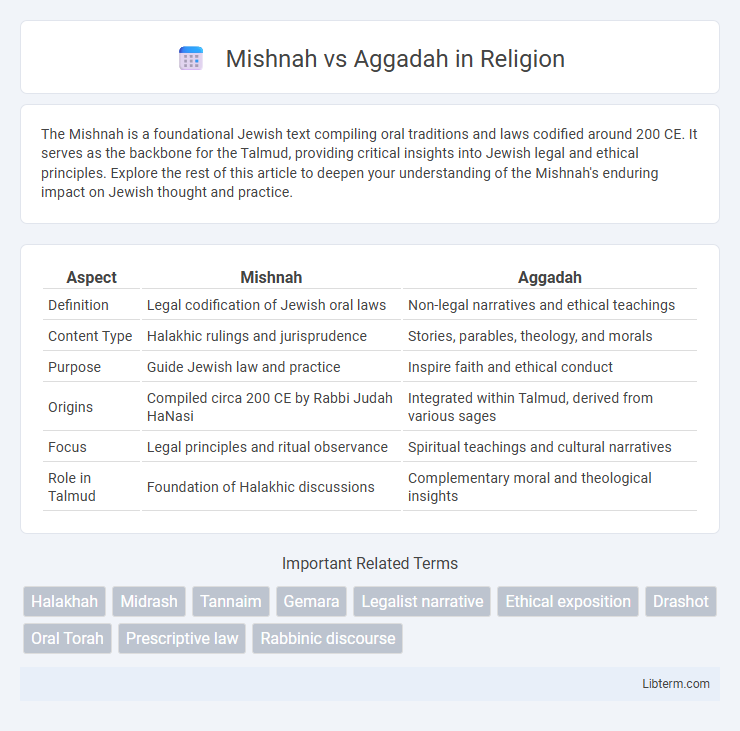The Mishnah is a foundational Jewish text compiling oral traditions and laws codified around 200 CE. It serves as the backbone for the Talmud, providing critical insights into Jewish legal and ethical principles. Explore the rest of this article to deepen your understanding of the Mishnah's enduring impact on Jewish thought and practice.
Table of Comparison
| Aspect | Mishnah | Aggadah |
|---|---|---|
| Definition | Legal codification of Jewish oral laws | Non-legal narratives and ethical teachings |
| Content Type | Halakhic rulings and jurisprudence | Stories, parables, theology, and morals |
| Purpose | Guide Jewish law and practice | Inspire faith and ethical conduct |
| Origins | Compiled circa 200 CE by Rabbi Judah HaNasi | Integrated within Talmud, derived from various sages |
| Focus | Legal principles and ritual observance | Spiritual teachings and cultural narratives |
| Role in Talmud | Foundation of Halakhic discussions | Complementary moral and theological insights |
Introduction to Mishnah and Aggadah
The Mishnah, compiled around 200 CE by Rabbi Judah the Prince, is a foundational text of Jewish oral law, systematically organizing legal rulings (Halakhah) across six orders. Aggadah, by contrast, encompasses the narrative, ethical, and theological components found in rabbinic literature, offering moral lessons, folklore, and biblical interpretation without strict legal framework. Understanding the Mishnah provides insight into the codification of Jewish law, while Aggadah enriches it through spiritual and cultural context.
Defining the Mishnah: Origins and Purpose
The Mishnah, compiled around 200 CE by Rabbi Judah the Prince, serves as the foundational text of Jewish oral law, systematically codifying legal rulings and traditions. Its primary purpose is to preserve and transmit halakhic (legal) teachings that govern daily life, religious practices, and ethical conduct within Judaism. Unlike Aggadah, which encompasses narrative, folklore, and moral teachings, the Mishnah is focused on precise legal frameworks and authoritative interpretations of the Torah.
Understanding Aggadah: Meaning and Scope
Aggadah encompasses the narrative, ethical teachings, and theological insights found within the Talmud and Midrash, offering profound moral guidance and spiritual lessons beyond legalistic discourse. Its scope includes stories, parables, and interpretations that illuminate Jewish values, traditions, and the human experience, providing context and depth to Halakhic texts like the Mishnah. Understanding Aggadah requires recognizing its role in shaping Jewish thought and cultural identity through allegory and symbolism rather than strict legal rulings.
Structural Differences Between Mishnah and Aggadah
The Mishnah is structured as a legal code consisting of concise, formalized rulings organized into six orders (Sedarim) and tractates (Masechtot), emphasizing halakhic (legal) discourse. Aggadah, in contrast, is less formally structured, containing narrative, ethical teachings, folklore, and theological reflections often interspersed throughout Talmudic discussions without a rigid organizational framework. While the Mishnah systematically codifies Jewish law, Aggadah offers expansive, interpretive content that complements and enriches the legal material with cultural and moral insights.
Legal Content vs. Narrative Material
Mishnah primarily comprises legal content, systematically codifying Jewish oral laws and commandments, serving as a foundational text for Halacha (Jewish law). In contrast, Aggadah contains narrative material, including folklore, ethical teachings, theological insights, and historical anecdotes, enriching the cultural and spiritual dimensions of Judaism. While Mishnah focuses on prescriptive legal rulings, Aggadah emphasizes interpretive stories and moral lessons that complement the legal framework.
Roles in Jewish Religious Life
The Mishnah serves as the foundational legal code in Jewish tradition, outlining laws and ethical guidelines that govern daily religious practices and communal conduct. Aggadah complements this legal framework by offering narrative, folklore, and theological insights that enrich Jewish spirituality and moral understanding. Together, the Mishnah and Aggadah shape the comprehensive fabric of Jewish religious life through law and storytelling.
Influence on Rabbinic Literature
The Mishnah serves as the foundational legal code within Rabbinic literature, systematically organizing Jewish oral laws and shaping halakhic discourse that guides religious practice. Aggadah, by contrast, enriches Rabbinic texts with narrative, ethical teachings, and theological reflections, providing cultural and moral context that influences interpretive traditions. Together, Mishnah and Aggadah form a complementary framework influencing the development of the Talmud and subsequent Rabbinic scholarship by balancing legal rigor with narrative creativity.
Philosophical and Ethical Dimensions
Mishnah emphasizes legal rulings and practical laws that shape Jewish ethical conduct and communal responsibilities, providing a structured framework for living a moral life. Aggadah explores philosophical themes, metaphysical ideas, and moral teachings through narrative and allegory, fostering ethical reflection and spiritual insight. Together, these texts complement each other by balancing concrete legal principles with profound ethical and philosophical wisdom.
Interpretation Methods and Study Approaches
Mishnah primarily employs a legalistic interpretation method centered on halachic principles, emphasizing precise textual analysis and systematic categorization of Jewish law. Aggadah, by contrast, utilizes a more narrative and allegorical approach, focusing on ethical teachings, folklore, and theological insights through metaphors and parables. Study of Mishnah often involves rigorous dialectical reasoning with commentaries like those of Rashi and Maimonides, while Aggadah encourages reflective and thematic exploration, engaging with the moral and spiritual dimensions of the texts.
Legacy and Contemporary Relevance
The Mishnah, as the foundational legal code of Jewish oral law, anchors contemporary Jewish practice by codifying ritual, civil, and ethical norms essential for religious observance and communal governance. Aggadah complements this legal tradition by offering rich narrative, ethical teachings, and theological insights that continue to inspire modern Jewish thought, culture, and spirituality. Together, the Mishnah and Aggadah form an integrated legacy that shapes both the legal framework and the moral imagination of contemporary Judaism.
Mishnah Infographic

 libterm.com
libterm.com